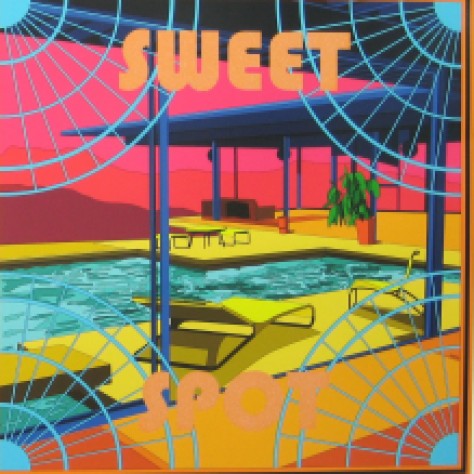JUNE 19, 2014

By E. S. Jones
Winston Churchill once remarked that ‘we shape our buildings, and afterwards our buildings shape us’. Will Martyr’s paintings appear to highlight this fascinating influence of architecture on the mind. As the environments we occupy are processed and interpreted by our senses, they inevitably contribute to identity and an overall satisfaction with daily life. From ceiling height to wall colour, the kind of places we inhabit have been proven to directly influence our behaviour. For example, shades of red will promote attention to detail and energy; while cooler colours lead to creative thinking, as ideas literally meander off into the blue.
Martyr’s landscapes are like diagrams of structures designed to bring about a sense of well-being. In our modern culture, beauty has been replaced by functionality; darker and uglier concrete blocks overshadow our streets, and contribute to feelings of hopelessness. Contrary to the ubiquitous slogan, it does not feel like we are ‘worth it’, but just another cog in a vast grey, windowless machine. Somewhere we’ve misplaced the importance of horizontal space, under the myriad desires for the vertical. Once upon a time the skyline was considered as a whole, now every new building wants to be known by its weird shape and peculiar nickname: The Gherkin, The Cheese Grater, The Walkie Talkie. Humorous as it all is, who actually wants to work inside a giant pickled cucumber? Bigger and better and taller Towers of Babel, they are a result of a craving for more visible power- but lead to an isolated and scattered community.
From the cure-all-ills holiday in the Swiss Alps to retirement by the sea, location has always been vital to health and recovery. As recorded by Marco Polo, the King of Kerman wondered why his nation should be so tranquil, while right next door the Persians were renowned for their savage fighting and cruel tempers. The story goes that the King’s advisors suggested bringing some Persian soil to the palace, hiding it under the carpets and holding a banquet. Upon arrival, the usually docile guests immediately turned on each other, proving a direct correlation between the physical ground and its affect on society.
As the King witnessed first hand, we are shaped by every element of our surroundings. We need openness, comfort and breathing space; our brains are wired to be wary of spiky edges, and are naturally drawn towards gracefully curved forms. Martyr’s buildings feel familiar, with sheets of light softly slanting through glass, hushing our jangled nerves as though we were stood under the arching ceiling of a cathedral. In his paintings, the roof over your head can be as endless as the sky, walls billow out like sails in the wind, quietly drifted out across the grassy sea. Sweeping lines remind us of rolling hills and distant horizons, even though there are no trees to speak of.
One of the most ridiculous moments of the last century was the construction of the ‘Millennium Dome’, a grand monument to ourselves. An enormous amount of planning and money appeared to go in- yet it remained completely deserted after completion for seven years. It became an apt metaphor for our disposable culture, where our promised ‘future’ was only emptiness and uncertainty. Perhaps it is time to stop treating our structures as a commodity, and return to building real shelters designed to inspire and last. Permanence rather than transience is an investment in the self, not just a foot-hold on the property ladder.
In giving more weight to the design of living and working spaces, the architect is like a magician- and we are the willing audience. Although the element of mystery vanished under Francis Bacon’s emphasis on rationality, we still long for something unexpected, that the rabbit will be pulled from the hat, ears and whiskers intact. Will Martyr’s canvases stir the imagination with a technique that mimics an architect’s process; every precise brushstroke is a brick emerging in three dimensions to lull and seduce. We know that there is more here than meets the eye, but find comfort in the illusion.
These beautiful paintings give us just enough of an insight into the trickery without giving away the game. The artist is a purist, presenting us with clean lines, smooth planes, satisfying symmetry and dominant geometry. He does not attempt cerebral explanations of architectural psychology, but hints at our deep seated longings for ‘home’ with his visions of the perfect tomorrow. These are truly bewitching blueprints, designed to restore a connection between our inner and outer worlds.
Will Martyr: ‘Stay Until Tomorrow’ is at Hay Hill Gallery, 35 Baker Street, London W1U 8EN from the 23rd June until the 19th July 2014. Private view- 24th June from 6-8pm, RSVP sarah@hayhillgallery.com.
